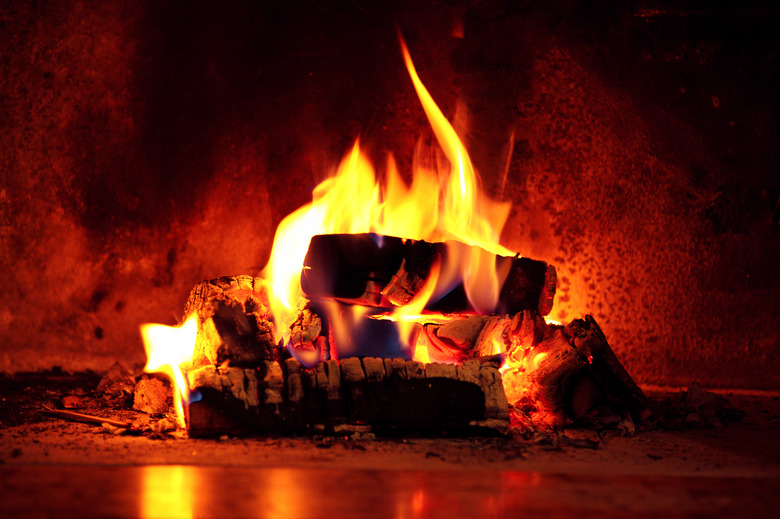How To Predict Products In Chemical Reactions
Chemistry students typically experience difficulty in predicting the products of chemical reactions. With practice, however, the process becomes progressively easier.
The first step—identifying the type of reaction involved—is usually the most difficult. The primary reaction types students encounter are displacement, acid-base and combustion. They are easily identified if the tell-tale signs are known. Displacement reactions involve two ionic compounds with cations and anions, such as sodium sulfate, in which sodium (Na?) is the cation and sulfate (SO?²?) is the anion. Ionic compounds always consist of a metal and a nonmetal or polyatomic (multiple-atom) anion. Decomposition reactions involve a single compound breaking into two or more compounds. Acid-base reactions must involve an acid (identified by its chemical formula that begins with "H," such as HCl). Combustion reactions involve hydrogen or a hydrocarbon (such as CH?) reacting with oxygen (O?).
Displacement Reactions
Step 1
Identify the cation and anion of the compounds involved in the reaction, as well as their charges. If necessary, refer to tables of cations and anions, such as the one available at Penn State University's website (See Resources). Sodium chloride (NaCl), for example, consists of a sodium ion (Na?) and a chloride ion (Cl?).
Step 2
Exchange the anions of the two reactants to determine the products of the reaction. Displacement reactions take this general form:
AB + CD ? AD + CB
Thus, for a reaction between sodium chloride (NaCl) and silver nitrate (AgNO?):
NaCl + AgNO? ? NaNO? + AgCl
Step 3
Determine whether the products are soluble. This may require referring to a list of "solubility rules," such as that at Southern Methodist University (see Resources). In the example from Step 2, NaNO? is soluble and thus remains in solution, but AgCl is insoluble and will form a precipitate.
Step 4
Verify that the reaction is balanced by adding coefficients in front of the reactants and products as necessary to ensure that each type of atom is present on each side of the reaction arrow in equal numbers. In the example from Step 2, the left side of the equation contains 1 Na, 1 Cl, 1 Ag, 1 N, and 3 O; the right side contains 1 Na, 1 Cl, 1 Ag, 1 N, and 3 O. Thus, the reaction is balanced.
Acid-Base Reactions
Step 1
Identify the acidic compound (containing H? in its formula) and the basic compound (usually a hydroxide, OH?).
Step 2
Determine the products according to the general reaction:
acid + base ? salt + water
For example, the reaction of hydrochloric acid (HCl) with sodium hydroxide (NaOH) produces sodium chloride and water:
HCl + NaOH ? NaCl + H?O
Step 3
Determine if the salt is soluble or insoluble by referring to the solubility rules.
Step 4
Balance the reaction. In this case, the reaction from Step 2 is already balanced.
Combustion Reactions
Step 1
Determine the fuel (the source of carbon and/or hydrogen) and the oxidant (the source of oxygen) (see Resources). If the combustion is carried out in air, the oxidant is assumed to be molecular oxygen (O?). Other oxidants, such as nitrous oxide (N?O), are possible, but this would require special reaction conditions.
Step 2
Predict the products by assuming this general reaction:
Fuel + oxidant ? CO? + H?O
For example, propane (C?H?) combines with O? during combustion as:
C?H? + O? ? CO? + H?O
Step 3
Balance the reaction. For the example in Step 2:
C?H? + 5 O? ? 3 CO? + 4 H?O
Things Needed
- Table of cations and anions (see Resources)
- Solubility rules (see Resources)
Cite This Article
MLA
Brubaker, Jack. "How To Predict Products In Chemical Reactions" sciencing.com, https://www.sciencing.com/predict-products-chemical-reactions-6385005/. 13 March 2018.
APA
Brubaker, Jack. (2018, March 13). How To Predict Products In Chemical Reactions. sciencing.com. Retrieved from https://www.sciencing.com/predict-products-chemical-reactions-6385005/
Chicago
Brubaker, Jack. How To Predict Products In Chemical Reactions last modified August 30, 2022. https://www.sciencing.com/predict-products-chemical-reactions-6385005/
